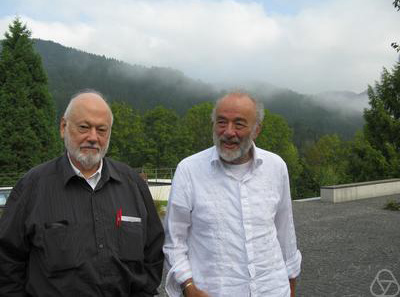(Virtual) Discrete & Computational Geometry Day
in Memory of Eli Goodman and Ricky Pollack
founding editors of D&CG
co-founders of this seminar
Organized by Springer, NYU, and CUNY

Tuesday, April 12, 2022, 12:30–16:05 ET (New York time)
Zoom link: https://springer.zoom.us/j/6440052748
A shiny flyer
A
YouTube playlist of video recordings of the meeting
Program:
12:30 Welcome & Introduction
12:40 Andreas Holmsen (KAIST): An allowable feast
13:15 Micha Sharir (Tel Aviv University):
Polynomial partitioning: The hammer and some (recent algorithmic) nails
13:50 Esther Ezra (Bar Ilan University): Recent
developments on intersection searching
14:25 Xavier Goaoc (Loria, Nancy): Some
questions on order types
15:00 Andrew Suk (UC San Diego): Unavoidable
patterns in simple topological graphs
15:35 Sylvain Cappell (Courant Institute): Mesh matrices of graphs, of simplicial complexes and of matroids and the significance of their eigenvalues
Abstracts
Andreas Holmsen (KAIST): An allowable feast
Eli and Ricky started their collaboration more than four decades ago,
and it is hard to overstate the impact they have had on the field of
discrete and computational geometry. In this talk I will highlight
some of their most influential results, such as their work on
allowable sequences, counting polytopes, and geometric transversals.
Micha Sharir (Tel Aviv University): Polynomial partitioning: The hammer and some (recent algorithmic) nails
We quickly review the polynomial partitioning technique introduced by
Guth and Katz more than 10 years ago. We review recent algorithms for
constructing partitioning polynomials, and discuss several recent
algorithmic applications, to range searching with semi-algebraic sets
and to various other problems. We highlight two recent and related
applications:
to collinearity testing for point sets, and to segment concurrency in
three families of disjoint segments.
Based on joint (and disjoint) work with (too) many people.
Esther Ezra (Bar Ilan University): Recent developments on
intersection searching
Algebraic techniques have been extensively used in discrete and
computational geometry since the early 1980's, beginning with the
seminal work of Schwartz and Sharir on the piano movers problem, where
they introduced techniques from real algebraic geometry. More
recently, Guth and Katz introduced the polynomial partitioning
technique and almost settled the classical distinct-distance
conjecture. Polynomial partitioning became a central tool in solving
incidence problems, as well as other main problems in discrete
geometry. Very recently, efficient constructions of partitioning
polynomials have led to the solution of fundamental algorithmic
problems in computational geometry, including eliminating depth
cycles, point location, and semi-algebraic range searching.
In this talk I will present several recent developments in the study
of intersection searching - a family of problems related to range
searching. I will first describe a solution to the ray-shooting
problem amid triangles in 3-space, where polynomial partitioning
serves as a main tool in order to obtain an efficient data structure
supporting ray-shooting queries. Then, I will show an extension of
this approach, which exploits additional tools in algebraic geometry,
resulting in efficient data structures for detecting intersections
amid flat objects in 3-space and semi-algebraic arcs.
This talk is based on several joint works with Pankaj Agarwal, Boris
Aronov, Matthew Katz, and Micha Sharir.
Xavier Goaoc (Loria, Nancy): Some questions on order types
This talk will discuss order types of point sets, from the
seminal contributions of Goodman and Pollack to more recent
developments.
Andrew Suk (UC San Diego): Unavoidable patterns in simple topological graphs
A simple topological graph is a graph drawn in the plane so that its
vertices are represented by points, and its edges are represented by
non-self-intersecting arcs connecting the corresponding points, with
the property that any two edges have at most one point in common. In
2003, Pach-Solymosi-Toth showed that every $n$-vertex complete simple
topological graph contains a topological subgraph on $m =
\Omega(\log^{1/8} n)$ vertices that is weakly isomorphic to the complete
convex geometric graph on m vertices, or the complete twisted graph on
$m$ vertices. Here, we improve this bound to $(\log n)^{1/4 - o(1)}$. This
is joint work with Ji Zeng.
Sylvain Cappell (Courant Institute): Mesh matrices of graphs,
of simplicial complexes and of matroids and the significance of
their eigenvalues
We report on some recent joint work with Edward Y. Miller on the
Mesh Matrices of Graphs and the significance of their eigenvalues. We
also
extend some of our results to Matroid settings.
